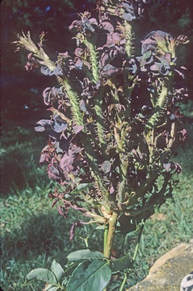
The disease is caused by the Rose Rosette Virus (RRV) and is transmitted by the eriophyid mite, Phyllocoptes fructiphylus. This mite is so small it cannot be seen with the naked eye. Current management focuses on prevention by buying uninfected stock, keeping current plants healthy and roguing out infected plants including nearby wild roses (Rosa multiflora).
It has been felt that miticides would be ineffective in controlling the disease. However, grant researchers decided to test various miticides anyway to document how effective (or ineffective) each was. Two different trials evaluated effectiveness of miticides over two years. What they found surprised them.
Specific miticides were used on a weekly schedule throughout the growing season with no rotation. In other words, each treatment used only one miticide rather than alternating miticides to avoid resistance. All miticides were used at the highest label rate. Control plants were sprayed with water.
One hundred percent of the control plants were infected with RRD. However, several miticides gave 100% prevention of the disease over the two-year period. Note these are preliminary results and we cannot give firm recommendations until this study is completed but this does open up a new avenue of control we did not expect.
So, what were the miticides? The products that were effective were Akari (fenpyroximate), Kontos (spirotetramal), Forbid (spiromesifen) and Talstar (bifenthrin). Two other treatments, horticultural oil and Avid + horticultural oil, gave good control the first year but not the second as disease pressure increased the second year. Sevin (carbaryl) was also in the test and was about as effective as water. Research is continuing and is looking at rates, timing and alternating miticides.
Commercial people who decide to try to prevent this disease by using these miticides should not use one miticide exclusively but should alternate products from different IRAC groups to prevent the buildup of resistance. Akari is in group 21A, Kontos and Forbid in group 23 and Talstar in group 3. Therefore, since Kontos and Forbid are in the same group, alternating between them would do no good. Applications should be made every two weeks.
For homeowners, we would suggest alternating horticultural oil and bifenthrin (Hi-Yield Bug Blaster Bifenthrin) on two week intervals throughout the growing season. In other words, spray with horticultural oil, wait two weeks, spray with bifenthrin and repeat throughout the growing season. Be careful of temperature restrictions on horticultural oil so pay attention to the label.
A very good publication on the control of RRD has come out of this research and is available at: http://hnr.k-state.edu/doc/extension/Rose_Rosette_Disease.pdf
Again, these are preliminary results and we have much to learn before we can make more specific recommendations. (Ward Upham)
 RSS Feed
RSS Feed
